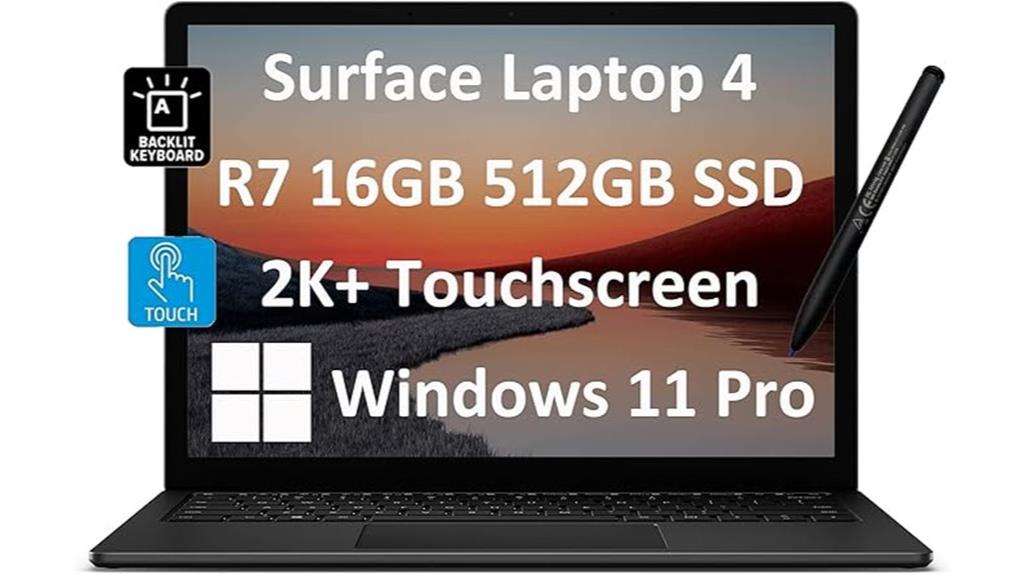The ASUS Vivobook Pro 16X positions itself as a powerhouse for creative professionals, boasting an Intel Core i9-13980HX and NVIDIA RTX 4070 GPU that promise seamless 4K editing and 3D rendering. Yet, beneath its impressive specs lies a series of compromises—thermal throttling, a plastic chassis, and underwhelming battery life—that raise questions about its long-term viability. While its raw performance is undeniable, the trade-offs in cooling efficiency and build quality leave room for debate. Is this laptop a true contender for professionals, or do its pitfalls outweigh its potential? The answer may not be as straightforward as it seems.
Key Takeaways
- High-performance Intel Core i9-13980HX and RTX 4070 GPU excel in creative tasks but face thermal throttling under heavy workloads.
- Shared 150W power limit restricts CPU and GPU performance, causing reduced efficiency during intensive tasks.
- 16-inch 3.2K OLED display offers vibrant colors and accuracy, ideal for creative professionals and media consumption.
- Plastic build quality and noisy cooling fans detract from premium feel and user experience during prolonged use.
- Limited battery life (1-1.5 hours under load) and thermal management issues hinder sustained performance in demanding applications.
##
While the ASUS Vivobook Pro 16X boasts impressive hardware specifications, including an Intel Core i9-13980HX CPU and NVIDIA GeForce RTX 4070 GPU, its performance is constrained by power limitations. The shared power limit of 150 watts between the CPU and GPU restricts the full potential of the RTX 4070, which operates at 80-90 watts instead of its 140-watt TDP. This limitation, combined with thermal throttling issues, impacts sustained performance during demanding tasks. The ASUS IceCool Pro thermal system, while upgraded, struggles to maintain ideal temperatures under heavy loads, leading to frequent thermal throttling. Additionally, users report significant fan noise complaints, as the dual fans ramp up aggressively to manage heat, creating a disruptive auditory experience during intensive workloads. These factors collectively hinder the device's ability to deliver consistent, high-end performance. The ROG Intelligent Cooling system used in the ASUS ROG Strix G16, with its liquid metal and Tri-Fan technology, demonstrates a more effective approach to managing heat and maintaining performance under heavy usage.
Features and Benefits
The ASUS Vivobook Pro 16X is equipped with an Intel Core i9-13980HX CPU and NVIDIA RTX 4070 GPU, delivering robust performance for demanding workloads such as AI processing and 3D rendering. Its DDR5 memory guarantees efficient multitasking and handling of data-intensive applications, while NVIDIA Studio Drivers optimize performance for creative professionals in rendering, video editing, and broadcasting. The 16-inch 3.2K OLED display with VESA Certified Display HDR True Black 500 ensures vibrant and accurate color reproduction, enhancing visual performance for creative tasks. These features collectively position the device as a powerful tool for both productivity and creative workflows.
Intel Core I9-13980hx CPU
Featuring 24 cores and 32 threads, the Intel Core i9-13980HX CPU delivers exceptional performance for demanding workloads, including neural network processing, 3D rendering, and high-end gaming. Built on Intel's hybrid architecture, it combines Performance and Efficient cores to optimize power and speed, achieving top-tier CPU benchmarks in multi-threaded tasks. However, its high power consumption and heat output can lead to thermal throttling under sustained loads, particularly when paired with the shared 150W power limit between the CPU and GPU. Despite this, the i9-13980HX excels in creative applications and AI-driven workflows, leveraging DDR5 memory for faster data processing. While its raw performance is impressive, users must manage thermal constraints to maintain consistent performance, especially during prolonged intensive tasks.
NVIDIA RTX 4070 GPU Performance
With a focus on delivering high-performance graphics and AI-driven capabilities, the NVIDIA GeForce RTX 4070 GPU in the ASUS Vivobook Pro 16X is designed to excel in demanding creative and gaming workflows. However, its performance is hindered by power limit constraints, as the GPU operates at 80-90 watts, substantially below its 140-watt TDP. This shared power limit of 150 watts between the CPU and GPU further restricts its potential, leading to gpu throttling issues under sustained workloads. While the GPU leverages NVIDIA Studio Drivers for enhanced rendering and AI tasks, thermal management challenges and insufficient power allocation limit its ability to consistently deliver peak performance. These constraints are particularly noticeable in resource-intensive applications, where the GPU struggles to maintain ideal clock speeds.
DDR5 Memory for Demanding Tasks
DDR5 memory in the ASUS Vivobook Pro 16X substantially enhances its capability to handle demanding workloads, such as neural network processing, 3D rendering, and multitasking. With a memory speed of up to 4800 MT/s, DDR5 outperforms its predecessor, DDR4, by delivering faster data transfer rates and reduced latency, which is critical for compute-intensive applications. The improved power efficiency of DDR5 also guarantees lower voltage requirements, reducing overall system power consumption while maintaining high performance. This is particularly beneficial for sustained workloads, where thermal management and energy usage are key considerations. The 32GB DDR5 configuration in the Vivobook Pro 16X provides ample capacity for large datasets and complex workflows, making it a robust choice for professionals in creative and technical fields.
NVIDIA Studio Drivers for Creators
Designed to optimize performance for creative professionals, NVIDIA Studio Drivers in the ASUS Vivobook Pro 16X provide a tailored solution for accelerating workflows in applications such as video editing, 3D rendering, and graphic design. These drivers guarantee seamless driver compatibility with industry-standard software like Adobe Creative Suite, Blender, and DaVinci Resolve, enhancing stability and reducing crashes during intensive tasks. By leveraging software optimization, the Studio Drivers unleash the full potential of the NVIDIA GeForce RTX 4070 GPU, delivering faster rendering times and smoother real-time previews. Additionally, they support AI-powered tools, enabling features like AI denoising and accelerated neural network processing. This integration guarantees creators can focus on productivity without interruptions, making the Vivobook Pro 16X a reliable choice for demanding creative workflows.
Product Quality
While the ASUS Vivobook Pro 16X excels in performance and features, its product quality presents a mixed experience, particularly in build durability and thermal management. The build quality, while aesthetically professional, relies heavily on plastic materials, resulting in noticeable flex, especially on the rear cover. This compromises long-term durability and raises concerns about structural integrity under stress. Thermal management, powered by ASUS IceCool Pro technology, struggles under heavy workloads, with high temperatures and noisy fans becoming prevalent. Despite upgraded heat pipes and dual fans, the shared power limit between the CPU and GPU exacerbates heat dissipation challenges, leading to potential overheating and reduced performance stability. These issues highlight a gap between the device's high-end specifications and its ability to sustain them reliably. Additionally, the AMD Ryzen 7 5800HS processor delivers impressive multitasking capabilities but may contribute to the thermal challenges under intensive use.
What It's Used For
The ASUS Vivobook Pro 16X is designed for demanding creative workflows and rendering tasks, leveraging its Intel Core i9 processor, NVIDIA RTX 4070 GPU, and NVIDIA Studio Drivers for optimized performance in video editing, 3D modeling, and AI applications. While capable of handling gaming and heavy multitasking, its shared power limit between CPU and GPU may constrain performance in sustained workloads. The device excels in productivity scenarios, though thermal management and battery life under heavy use remain limiting factors for extended sessions. The ROG Intelligent Cooling system ensures efficient heat dissipation, supporting sustained performance during intensive tasks.
Creative Workflows and Rendering
With its Intel Core i9-13980HX CPU and NVIDIA GeForce RTX 4070 GPU, the ASUS Vivobook Pro 16X excels in handling demanding creative workflows, including 3D rendering, video editing, and AI-driven tasks. The combination of DDR5 memory and NVIDIA Studio Drivers guarantees efficient rendering optimization techniques, enabling faster processing of complex projects. However, the shared 150W power limit between the CPU and GPU can constrain performance during sustained workloads. ASUS IceCool Pro thermal technology mitigates thermal throttling solutions, but high temperatures under heavy load remain a concern. Despite these limitations, the laptop's hardware configuration is well-suited for professionals requiring robust performance in applications like Blender, DaVinci Resolve, and Adobe Creative Suite, provided thermal management is carefully monitored.
Gaming and AI Applications
Beyond its prowess in creative workflows, the ASUS Vivobook Pro 16X demonstrates strong capabilities in gaming and AI-driven applications, leveraging its NVIDIA GeForce RTX 4070 GPU and Intel Core i9-13980HX CPU. The GPU, though limited to 80-90 watts compared to its 140-watt TDP, delivers solid performance in modern titles and AI tasks like neural network training. However, the shared 150-watt power limit between the CPU and GPU can lead to thermal throttling under sustained loads, impacting peak performance. Despite this, the laptop's power efficiency is commendable, balancing high-end tasks with manageable heat dissipation. The RTX 4070's Tensor and CUDA cores further enhance AI workloads, making it a viable choice for developers and gamers seeking a portable yet powerful solution, albeit with some thermal compromises.
Heavy Multitasking and Productivity
While the ASUS Vivobook Pro 16X excels in creative and gaming applications, its performance in heavy multitasking and productivity scenarios is equally remarkable, thanks to its Intel Core i9-13980HX CPU and 32GB of DDR5 RAM. The high core count and fast memory enable seamless handling of demanding workloads, such as running multiple virtual machines, large datasets, or resource-intensive software suites. However, power limit constraints and thermal throttling issues can occasionally hinder sustained performance under prolonged heavy loads. The shared 150W power budget between the CPU and GPU may lead to reduced efficiency when both components are taxed simultaneously. Despite these limitations, the laptop remains a strong contender for professionals requiring robust multitasking capabilities, provided workloads are managed to avoid pushing the system beyond its thermal and power thresholds.
Product Specifications
The ASUS Vivobook Pro 16X is equipped with high-end hardware, featuring an Intel Core i9-13980HX CPU and an NVIDIA GeForce RTX 4070 GPU, paired with 32GB of DDR5 RAM and a 1TB SSD, making it a robust choice for demanding workloads. The device leverages NVIDIA Studio Drivers for optimized performance in creative applications, while its 90WHrs battery capacity guarantees limited but functional runtime under moderate use. Thermal efficiency is managed by ASUS IceCool Pro technology, which includes upgraded heat pipes and dual fans, though high temperatures under heavy load remain a concern. The 15.6-inch FHD touchscreen display enhances user interaction and experience, making it ideal for both creative and professional tasks. Below is a summary of key specifications:
| Component | Specification |
|---|---|
| Processor | Intel Core i9-13980HX |
| GPU | NVIDIA GeForce RTX 4070 |
| RAM | 32GB DDR5 |
| Storage | 1TB SSD |
Who Needs This
Designed for professionals and enthusiasts who demand high-performance computing, the ASUS Vivobook Pro 16X caters to users engaged in resource-intensive tasks such as 3D rendering, video editing, AI development, and gaming. Its Intel Core i9-13980HX CPU, NVIDIA GeForce RTX 4070 GPU, and 32GB DDR5 RAM guarantee seamless handling of demanding workflows, making it ideal for creators and developers. However, its high price and power-hungry components make it less suitable for casual users or budget buyers seeking affordability and simplicity. The laptop's thermal and battery limitations further underscore its niche appeal, as it excels under heavy workloads but struggles with prolonged portability. For those prioritizing raw performance over cost or everyday usability, the Vivobook Pro 16X is a compelling choice, though it may not align with the needs of general consumers. The inclusion of a factory-calibrated display ensures accurate color reproduction, which is crucial for creative professionals working on graphic design or video editing tasks.
Pros
Boasting a robust Intel Core i9-13980HX CPU and NVIDIA GeForce RTX 4070 GPU, the ASUS Vivobook Pro 16X delivers exceptional performance for demanding workflows, including 3D rendering, AI development, and high-end gaming. Its 32GB DDR5 RAM and 1TB SSD guarantee seamless multitasking and rapid data access, while NVIDIA Studio Drivers optimize creative applications. Despite portability concerns due to its weight and limited battery life under heavy use, the device excels in professional environments where power and performance are prioritized. The Adaptive-Sync Technology ensures smooth visuals by eliminating screen tearing and stuttering, enhancing the overall user experience.
- High-performance hardware: Ideal for intensive tasks like AI training and 4K video editing.
- Immersive display: 16-inch 16:10 IPS panel with ultra-slim bezels enhances productivity.
- Efficient cooling: ASUS IceCool Pro technology manages heat effectively during prolonged workloads.
- Versatile connectivity: Includes USB-A, USB-C, HDMI, and SD card slots for seamless integration.
Cons
While the ASUS Vivobook Pro 16X excels in raw performance, its thermal management system struggles under sustained heavy workloads, leading to high temperatures and noisy fan operation. The shared power limit between the CPU and GPU further exacerbates thermal throttling, impacting performance during extended tasks. Additionally, the battery life is underwhelming, lasting only 1-1.5 hours under heavy use, necessitating frequent charging. These issues, combined with a plastic build prone to flex, detract from its otherwise premium appeal. The CoolerBoost 5 technology found in competing models like the MSI Katana 15 highlights the importance of advanced cooling solutions for maintaining performance under load.
- Thermal management: High temperatures and noisy fans under load.
- Battery life: Limited runtime, especially during demanding tasks.
- Build quality: Plastic chassis with noticeable flex.
- Power sharing: Shared 150W limit between CPU and GPU reduces efficiency.
What Customers Are Saying
Although the ASUS Vivobook Pro 16X has garnered praise for its robust performance in creative and AI-driven workflows, customer feedback highlights recurring concerns regarding its thermal performance and build quality. Many users report overheating during intensive tasks, with temperatures exceeding comfortable thresholds, even with ASUS IceCool Pro technology. Customer complaints also cite noisy cooling fans and occasional fan failures, impacting user satisfaction. The plastic chassis, while lightweight, has been criticized for its flex and perceived lack of durability. Additionally, some users note audio glitches, random shutdowns, and software instability, further detracting from the overall experience. Despite these issues, the laptop's powerful hardware and display quality remain key selling points, though thermal and build-related shortcomings continue to divide opinions among users. The liquid metal cooling system found in the ASUS ROG Strix G15 could offer a potential solution to these thermal challenges, as it efficiently dissipates heat and maintains peak performance during extended use.
Overall Value
The ASUS Vivobook Pro 16X presents a compelling proposition for professionals and power users seeking high-performance hardware in a portable form factor. Its Intel Core i9-13980HX CPU, NVIDIA RTX 4070 GPU, and 32GB DDR5 RAM deliver exceptional performance for creative workflows and demanding tasks. However, a price comparison reveals it competes closely with alternatives like the Dell XPS 17 and MacBook Pro 16, which offer superior build quality and thermal management. While the Vivobook Pro 16X excels in raw power, its shared power limit and cooling limitations hinder sustained performance. Competitor analysis highlights its value for budget-conscious users prioritizing specs over premium materials, though its plastic build and thermal issues may deter those seeking long-term reliability. For its price, it remains a strong contender but with notable compromises. The Intel Arc A370M Graphics in competing models like the Dell XPS 15 9530 enhances visual quality, offering smoother frame rates and better rendering for creative tasks, which could be a consideration for users prioritizing graphical performance.
Tips and Tricks For Best Results
To maximize the performance and longevity of the ASUS Vivobook Pro 16X, users should prioritize enhancing its thermal management and power settings. For thermal improvement, make certain the laptop is placed on a flat, hard surface to improve airflow and consider using a cooling pad during intensive tasks. Adjust the fan profile via ASUS software to balance noise and cooling efficiency. For battery management, enable power-saving modes when unplugged and limit background processes to extend runtime. Regularly update NVIDIA Studio Drivers and BIOS to enhance stability and performance. Avoid prolonged high-load scenarios to prevent overheating and potential hardware degradation. These practices will help maintain peak performance and mitigate common issues like thermal throttling and reduced battery life.
Conclusion
While the ASUS Vivobook Pro 16X excels in delivering robust performance for creative professionals and demanding workloads, its overall value proposition is tempered by several notable limitations. The device's thermal solutions, while advanced with ASUS IceCool Pro technology, struggle to maintain ideal temperatures under heavy loads, leading to overheating and fan noise. Future upgrades to the cooling system and power delivery could enhance its stability and efficiency. Additionally, the shared power limit between the CPU and GPU restricts gaming and intensive task performance. Despite its impressive specifications, the plastic build quality and limited battery life further detract from its appeal. For users prioritizing raw power over portability, the Vivobook Pro 16X remains a viable option, but its shortcomings highlight areas for improvement.




